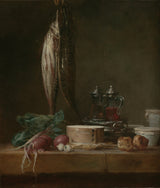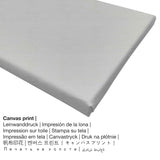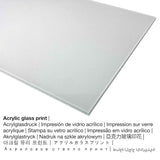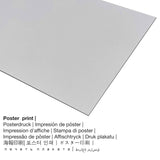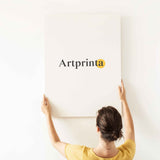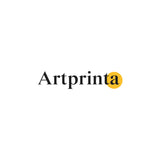Jean-Baptiste-Siméon Chardin, 1769 - Still Life with Fish, Vegetables, Gougères, Pots - fine art print
Tax included. Shipping calculated at checkout.
In 1769 the painter Jean-Baptiste-Siméon Chardin created the classic art artpiece. The over 250 year-old original creation was painted with the size: 68,6 x 58,4 cm. Oil on canvas was used by the European artist as the medium of the artwork. This piece of art belongs to the digital art collection of The J. Paul Getty Museum located in Los Angeles, California, United States of America. With courtesy of The J. Paul Getty Museum (public domain license).Creditline of the artwork: . Besides, the alignment is portrait and has a side ratio of 1 : 1.2, which implies that the length is 20% shorter than the width. The painter Jean-Baptiste-Siméon Chardin was an artist, whose artistic style was primarily Baroque. The painter was born in the year 1699 in Paris and deceased at the age of 80 in 1779 in Paris.
Available product materials
The product dropdown menu gives you the opportunity to pick the material and sizeaccording to your preferences. You can select your preferred material and size between the following choices:
- Aluminium dibond (metal print): Aluminium Dibond prints are prints on metal with a true depth effect - for a modern impression and a non-reflective surface structure. A direct Aluminium Dibond Print is your perfect introduction to the sophisticated world of fine art reproductions made with aluminum. The bright sections of the artwork shine with a silky gloss, however without glow. The direct print on aluminium is the most popular entry-level product and is a truly stylish way to showcase fine art prints, because it puts 100% of the viewer’s focus on the whole artwork.
- The canvas print: The canvas print, which should not be mistaken with an artwork painted on a canvas, is a digital copy applied on a cotton canvas material. Your printed canvas of this artpiece will let you turn your art print into a large size artwork like you would see in a gallery. How can I hang a canvas print on my wall? A canvas print has the advantage of being low in weight. This means, it is easy to hang up your Canvas print without additional wall-mounts. Canvas prints are suitable for all kinds of walls.
- The poster print (canvas material): The poster print is a UV printed canvas paper with a slight structure on the surface, that reminds the original masterpiece. It is particularly designed for placing the art print using a custom frame. Please keep in mind, that depending on the absolute size of the poster print we add a white margin 2-6cm around the print to facilitate the framing with a custom frame.
- Print on glossy acrylic glass (with real glass coating): An print on acrylic glass, often labelled as a an art print on plexiglass, will convert your chosen original into great home décor. With an acrylic glass fine art print sharp contrasts plus small image details will be more identifiable because of the subtle tonal gradation.
Disclaimer: We try whatever we can to describe the art products in as much detail as possible and to showcase them visually. At the same time, the colors of the print products and the printing may differ somehwat from the image on the device's monitor. Depending on the settings of your screen and the condition of the surface, colors may not be printed as exactly as the digital version shown here. Since all the art reproductions are printed and processed manually, there may also be minor differences in the exact position and the size of the motif.
Structured item details
| Article type: | fine art reproduction |
| Method of reproduction: | digital reproduction |
| Production technique: | digital printing (UV direct print) |
| Provenance: | German production |
| Type of stock: | production on demand |
| Intended product usage: | wall picture, wall art |
| Alignment of the image: | portrait alignment |
| Side ratio: | length to width 1 : 1.2 |
| Image aspect ratio implication: | the length is 20% shorter than the width |
| Fabric variants: | acrylic glass print (with real glass coating), poster print (canvas paper), metal print (aluminium dibond), canvas print |
| Canvas on stretcher frame (canvas print): | 50x60cm - 20x24", 100x120cm - 39x47", 150x180cm - 59x71" |
| Acrylic glass print (with real glass coating): | 50x60cm - 20x24", 100x120cm - 39x47", 150x180cm - 59x71" |
| Poster print (canvas paper) variants: | 50x60cm - 20x24", 100x120cm - 39x47" |
| Aluminium print (aluminium dibond material) size variants: | 50x60cm - 20x24", 100x120cm - 39x47" |
| Frame: | without frame |
Background information on the unique artwork
| Title of the artwork: | "Still Life with Fish, Vegetables, Gougères, Pots" |
| Artwork classification: | painting |
| Generic term: | classic art |
| Century: | 18th century |
| Year of creation: | 1769 |
| Artwork age: | 250 years old |
| Painted on: | oil on canvas |
| Original size (artwork): | 68,6 x 58,4 cm |
| Museum / collection: | The J. Paul Getty Museum |
| Location of museum: | Los Angeles, California, United States of America |
| Website: | www.getty.edu |
| License type: | public domain |
| Courtesy of: | The J. Paul Getty Museum |
Short overview of the artist
| Name of the artist: | Jean-Baptiste-Siméon Chardin |
| Gender: | male |
| Artist nationality: | French |
| Jobs: | painter |
| Country: | France |
| Classification of the artist: | old master |
| Art styles: | Baroque |
| Lifetime: | 80 years |
| Birth year: | 1699 |
| Place of birth: | Paris |
| Died: | 1779 |
| Died in (place): | Paris |
Copyright © | www.artprinta.com (Artprinta)
Original artwork description from the museum's website (© - by The J. Paul Getty Museum - www.getty.edu)
Nobody has a greater understanding of the harmony of color and reflections. Ah, Chardin, what you grind on your palette is not this color or that, red, black, or white, but the very substance of things.
Jean-Siméon Chardin impressed critic Denis Diderot with his unique style and impeccable technique, which he applied to what was then considered a lowly genre, the still life. Exemplifying what Diderot noticed in his paintings, Chardin here transforms a simple kitchen scene with a subtle palette, innovative composition, and virtuoso brushwork.
The objects' arrangement is spare but dynamic: Two mackerels hang vertically in front of a plain background, perpendicular to an arrangement of food on the tabletop below. Brilliant light directs the eye, attracting attention to the shiny fish, leafy greens, root vegetables, a wheel of cheese, and covered bowls. Although the overall palette is subdued, the oil and vinegar cruets are infused with rich color. The signature and date in the lower right corner are the last Chardin is known to have applied to a still life.

